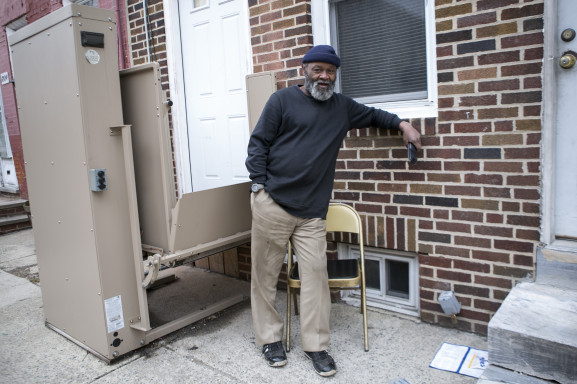
Seventy-year-old Tom Stack hobbles over to his ivy-green recliner and leans back, lighting a cigarette and hoisting his metal cane between his legs. He then stares over the room, points — sans hauteur or pomp — to his assortment of hard-to-come-by antiques and custom-crafted decorations and trails off into a synopsis of life on the 1700 block of Wharton Street.
“I integrated this block,” Stack jests. “You know what they call me? The ‘OG’: Old Guy.”
Walking into his home is akin to beholding Wonderland for the first time: a swirling red-metal art fixture complements a bevy of paintings on the living room wall, the kitchen is loaded with flowers and greenery and above the television are two model pirate ships hand-crafted by a friend in San Diego. It’s a time-devouring project Stack tackled four years ago when he, at first, rented the house, eventually purchasing it as a sort of blank canvas for decorating.

As well, the colorful and immaculate interior of his home is the kind of pleasantry that serves as a reminder of how neighborhoods — this one included — are better defined by the merit of their insides than outside aesthetics.
“We don’t have any ‘bad guys’ here,” Stack says. “But then, South Philly is a totally different neighborhood — you go one block south, and it changes.”
Stack’s life on the block is one of existence rather than involvement, minus the occasional trips to Olivares Food Market across the way at 1718 Wharton St., he does little else with his time except lounge and concoct new ideas for his home. But that’s not to discredit his contributions as the neighborhood’s “OG.”
“On the side, quietly, I help a lot of the younger guys down here who need advice,” he says. “A lot of them don’t have fathers, and it took a while, but they come in here and we sit and talk so they have someplace to go. … As a captain in the Marine Corps, I had a company of 160 guys, and most were under 19. So, I’m used to dealing with young guys. But I don’t treat these guys like I would my men – those guys, I’d say ‘Jump!’ and they’d say ‘How high?’”

He laughs, incense vapor streaming past his face.
“But it’s different now, and I’m more mellow,” Stack says. “It’s called ‘age.’”
Carmen Russ, a Temple University graduate who grew up on the block, recalls it being as mellow a place to live as Stack’s age-reshaped demeanor.

“It’s pretty calm and quiet around here. Except for the ruckus I bring in when I drive in with my music all loud, actin’ crazy!” Russ bellows, posing and pointing to a license plate on her car that reads “DIVAH.” “But there a lot of people here, a lot of little kids. … It used to be just [my family and I], a couple people next door and these few houses [on my block]. And the street was always bombarded with people runnin’ down the street, but it wasn’t bad.”

Jerome Ward is one of the residents who has had children running around. He has lived on the block for the past 20 years, raising his children and now caring for his ex-wife, who, as evidenced by a wheelchair ramp attached to his stoop, deals with disability.
“I lived in this neighborhood all my life; this is the best block I’ve lived on. It’s a very good block, and the people are good people – white and black. Because we got ‘em both,” Ward says. “Those other blocks, there’s a lot of shit. And you gotta fight. Here, everybody watches everybody.”
Clara Esantos, who has owned Olivares — the market Stack frequents — for five years, has been watching and recounts seeing fights. But, she emphasizes, she’s never experienced any personal problems.

“Everyone’s nice here,” she says. “The neighborhood’s changing, but everything’s going well. And business is improving.”
Seemingly, what none of the above residents are paying particularly close attention to is the sharp degree to which change is sprouting up in the neighborhood – namely, brand-new homes, shifting demographics and a coffee joint that have all emerged in the past year. That coffee shop, The Pharmacy, is of particular note and something some residents barely know exists.
“I don’t drink coffee. Why would I be in there if I don’t drink coffee?” Ward asks, straight-faced. “Do they got Bud Ice in there?”
The Pharmacy’s owner, Gary Viteri (pictured above), sees this sort of nonchalance as just part of the cycle of an evolving neighborhood – a symbol of comfort, complacency and, perhaps, developments to come.
“[My coffee shop] is something that’s been talked and talked and talked about this past two years, to the point where even the people who were excited about it are just like, ‘Yeah, we’re used to it. That’s been going on,’” says Viteri, who lives above his coffee shop. “That’s part of change, because eventually it becomes an unspoken thing. All of a sudden, a neighborhood that wasn’t here is here, but people are like, ‘Oh, that’s true. That’s not a big deal.’ But two years ago, when the neighborhood wasn’t here, it was a huge deal.”
“People don’t change when they see the light,” he adds, “people change when they feel the heat.”
– Text, video and images by Brandon Baker and Kate McCann


Be the first to comment